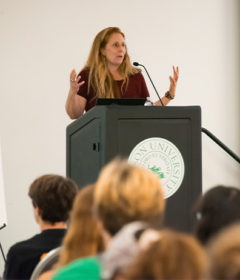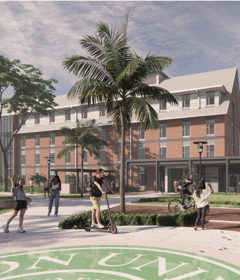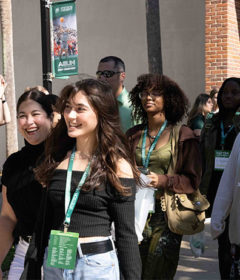Celebrating Research
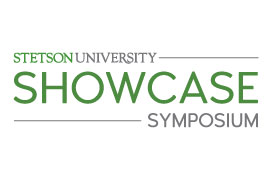
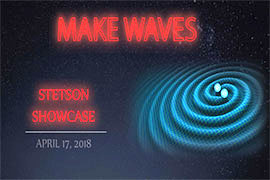
Katie (Kinnecom) Young participated in Stetson Showcase before she graduated in 2003. Young now works at Bunker Hill Community College in Boston as an adjunct professor of anatomy and physiology after beginning her career in the Neurology Clinical Trials Unit at Harvard Medical School’s teaching hospital.
Following Stetson Showcase and graduation in 2012, Christine Jacobson worked for cultural exchange programs in New York and Moscow. Today, she’s a librarian at the Harvard Kennedy School of Government Library while also working on a master’s in archives management at Simmons College.
Matthew Vanaman ’16, less than two years removed from Stetson Showcase, now is pursuing a doctorate in basic and applied social psychology at the Graduate Center of the City University of New York. Of particular interest is this question: Are some things “just wrong” because they feel wrong, even though they are harmless? The answer, according to Vanaman, might explain much about the origin of morality.
Here’s one more: Lyric soprano Jenna Siladie ’11 now earns acclaim from The New York Times and The Wall Street Journal, as she triumphs on stages throughout North America and Europe. Her journey began at Stetson’s School of Music and with Stetson Showcase.
Welcome to Stetson Showcase, with the 2018 version – the event’s 20thanniversary – set for April 17.
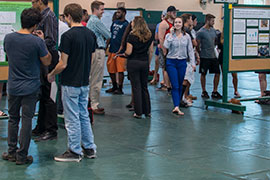
Considering the successes of past participants, this will be a celebration of research achievement by current students, who have worked on the projects throughout their senior year, say event organizers. Think everything from music recitals to experiments involving rat brains, all offered by many of the best and brightest at Stetson via posters, oral presentations, art exhibits, slide shows, business portfolios, filmography and play scenes, among other displays.
Last year, 225 graduating seniors showcased and presented their efforts, representing a broad spectrum of academic disciplines. Approximately the same total of students is expected this year. Student participation is dictated by the specific requirements of their majors. Students may participate as individuals or as teams, with all projects monitored and approved for presentation by faculty members.
Host sites are indicative of the event’s diverse nature. Campus locales range from the DuPont Ball Library, the Lynn Business Center and Sage Hall to Lee Chapel, Elizabeth Hall and the Holler Fieldhouse.
To encourage student attendance across campus, classes are canceled for the day. Also, the event is open to the public, beginning at 8:30 a.m. A short printed program of the schedule will be available, and more detailed information is available online.
This year’s theme is “Make Waves,” keynoted by Stetson physics alumna Sarah Caudill ’06, herself once a Showcase standout who two years ago had a hand in the “discovery of the century” – involving the direct detection of gravitational waves from two colliding black holes. In 2012, Caudill received a doctorate in gravitational wave physics from Louisiana State University and was a member of the support team that won the 2017 Nobel Prize in Physics.
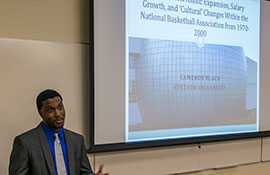
Label the event a launching pad for careers or the culmination of undergraduate study. Either way, Stetson Showcase is special, asserted Kimberly Reiter, Ph.D., associate professor of ancient and medieval history and chair of the Stetson Undergraduate Research Committee.
“There are many universities and colleges across the country that have some kind of recognition day for their best students. Stetson is above most of them,” said Reiter, who also serves as a national councilor for undergraduate research and on the Florida Undergraduate Research Council.
Reiter goes on to explain, pointing to the past two decades. “We are one of the oldest comprehensive showcase day in the country. … We have a wealth of research from which to draw. I go to [national Conference for Undergraduate Research] meetings and I have to try very hard not to keep interjecting, because a lot of talk is about ‘how do we get undergrads to do research?’ When it comes to Showcase, we don’t have to scramble for people; we’ve got them,” Reiter said.
Stetson’s small class faculty/student ratios help to foster stronger relationships, which historically have enhanced students’ commitment to Showcase, Reiter added.
Professor Kevin Riggs, Ph.D., chair of the physics department and the founding chair of Stetson Showcase, agrees, describing the event’s support from the Stetson community as “highly gratifying” and adding the “sophistication of the projects presented never fails to impress.”
“It does not seem possible that we are celebrating 20 years of wonderful undergraduate research presentations,” said Riggs. “I can remember sitting in a faculty meeting discussing the idea of starting an undergraduate research symposium at Stetson and thinking to myself that this could be a great experience and even a life-changing event for our students.”
For graduating senior Maria Shimkovska, a computer science major, Stetson Showcase is an “opportunity for students to simply present something they’ve worked days and months on.”
“It’s really cool because it is easy to kind of get in your own bubble, going from class to class and doing homework, but for Showcase you present something that is beyond what you do in classes. You get to use that knowledge and apply it,” Shimkovska said. “And students also have an audience, which in turn creates this kaleidoscope of learning, almost.”
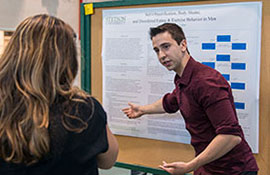
Notably, while science projects largely will be clustered, Stetson’s interdisciplinary academic approach also will be on display. “A sociology major may be presenting next to a history major, who may be presenting next to an English major,” Reiter said.
“Often,” Shimkovska noted, “you can mentally link your own interests to [the interests of others students] and see how connected our studies are, despite the different majors.”
For the first time, business students will have their own venue, as a way to emphasize the breadth and depth of their work. “We want to get a message out to the entire university. [Business students] are just as good as everybody else with the research they’re doing,” Reiter commented.
In addition, all projects are judged, and students will be measured not only on the substance of their work, but on how it is presented. “The judges want to see that the students can get out of Presser or Sage or Flagler [halls] and explain the greater impact of their work to a person who is not in that department.” Reiter said. “You’ve got to showcase not merely to people in your department, but to a liberal-arts university that really wants to know.”
Reiter is confident the university, and all others, will be duly impressed.
“We are able to put together an amazing Showcase,” Reiter concluded, “because we have an embarrassment of riches in undergraduate research.”
-Michael Candelaria

